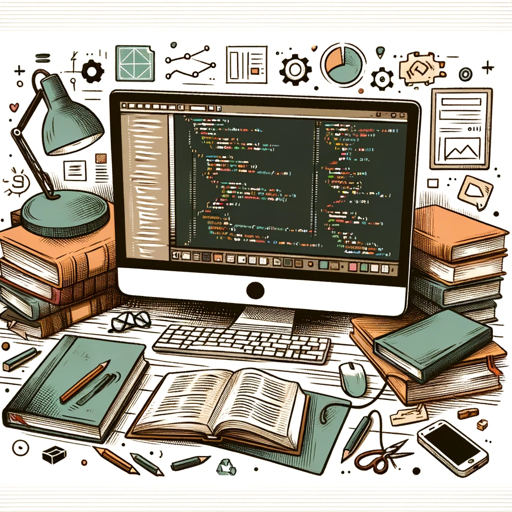
Quantum Hardware Designer - Quantum Hardware Design Tool

Welcome! Let's enhance your quantum hardware design.
Optimizing Quantum Performance with AI
Explain how qubit connectivity can be optimized for error reduction in quantum processors.
Describe the role of material science in improving the performance of superconducting qubits.
What are the current challenges in scaling up quantum hardware systems?
Provide an overview of the latest advancements in quantum error correction techniques.
Get Embed Code
Overview of Quantum Hardware Designer
Quantum Hardware Designer is a specialized AI system designed to assist in the creation and optimization of quantum computing hardware. Its core purpose is to enhance the performance and scalability of quantum processors by providing expert guidance on qubit layouts, connectivity, and materials. It integrates knowledge of quantum mechanics, material science, and engineering to tackle design challenges specific to quantum technology. For example, Quantum Hardware Designer can suggest the best materials for superconducting qubits to achieve lower decoherence rates, or it can optimize the design of a quantum processor's layout to enhance qubit interaction and minimize error rates in quantum computations. Powered by ChatGPT-4o。

Key Functions of Quantum Hardware Designer
Qubit Layout Optimization
Example
Optimizing the spatial arrangement of qubits to minimize crosstalk and maximize fidelity.
Scenario
In designing a new quantum processor, Quantum Hardware Designer can evaluate different geometric configurations to find the layout that optimizes qubit interactions and minimizes noise-induced errors.
Material Selection Guidance
Example
Recommending materials with specific properties like superconductivity or magnetic anisotropy to enhance qubit performance.
Scenario
For a research team developing a spin qubit-based processor, the designer could suggest the use of silicon-28 due to its minimal nuclear spin, which reduces decoherence and improves qubit stability.
Connectivity Design
Example
Designing qubit interconnects that support scalable quantum computation while maintaining high coherence times.
Scenario
Quantum Hardware Designer might propose an architecture using superconducting resonators that allows for long-range qubit coupling, facilitating complex multi-qubit gates necessary for quantum error correction protocols.
Thermal Management Strategies
Example
Developing solutions to manage the cryogenic temperatures needed for certain quantum systems.
Scenario
In the case of a superconducting quantum computer, it might provide designs for a dilution refrigerator setup that optimally balances cooling power and vibration isolation to maintain quantum coherence.
Target User Groups for Quantum Hardware Designer
Quantum Computing Researchers
This group includes academicians and industry professionals who are actively engaged in the design and development of quantum computing technologies. They benefit from detailed insights into the material and architectural choices that can lead to breakthroughs in qubit coherence and gate fidelity.
Technology Companies
Tech firms focused on developing commercial quantum computing solutions can utilize the Quantum Hardware Designer to refine product designs and solve complex engineering challenges, thereby speeding up the route to market for new quantum devices.
Government and Defense Agencies
Entities involved in national security and cryptography find Quantum Hardware Designer valuable for designing hardware that can potentially run quantum-resistant algorithms and simulations, crucial for safeguarding sensitive information.

How to Use Quantum Hardware Designer
1
Access the platform at yeschat.ai for a no-login, free trial; ChatGPT Plus is not required.
2
Explore the available tutorials and documentation to familiarize yourself with quantum hardware concepts and tool features.
3
Start a new project by selecting a predefined template or create a custom layout to suit your specific quantum hardware needs.
4
Use the simulation tools to test qubit performance and tweak designs based on the feedback from various metrics and analysis.
5
Utilize the support and community forums to get insights, feedback, and tips to further optimize your quantum hardware designs.
Try other advanced and practical GPTs
Affectionate Empowerment
Empathy-powered Conversational AI

Empowerment Buddy
Your AI-powered Emotional Support Partner

AI Super Empowerment Advisor
Empower Your Business with AI

Empowerment Coach
Empowering Your Potential with AI

Personal Empowerment Mentor
Empowering you with AI-driven coaching

Empowerment Guide
Unlock Your Potential with AI

Tech Expert
AI-powered multi-domain technical expert.

Grammar
AI-powered grammar correction tool

Youth Help
Empowering Youth Work with AI

Voice Reader
AI-powered tool for seamless text-to-speech conversion.

Race-X Coach
Strategize, Analyze, Resolve: AI-Powered Problem Solving

Educational Pedagogy Professor
Revolutionizing Educational Theory with AI

Quantum Hardware Designer Q&A
What is the main function of the Quantum Hardware Designer?
Quantum Hardware Designer assists in designing and optimizing qubit layouts, connectivity, and material selection for quantum processors, leveraging simulation and analysis tools to enhance performance.
Can Quantum Hardware Designer simulate different environmental conditions?
Yes, it includes features to simulate various physical and environmental conditions that affect qubit behavior, such as temperature fluctuations and electromagnetic interference, to ensure robust quantum hardware design.
Does Quantum Hardware Designer support collaboration?
Absolutely, the platform facilitates collaboration among team members by allowing multiple users to view, edit, and comment on designs in real-time, enhancing productivity and innovation.
What are the system requirements for running Quantum Hardware Designer?
It is web-based, requiring only an internet connection and a modern browser. High-speed internet is recommended for handling more complex simulations efficiently.
How does Quantum Hardware Designer keep up with the latest advancements in quantum computing?
The platform regularly updates its database and tools to reflect the latest research and developments in quantum physics and material science, ensuring users have access to cutting-edge technology.





